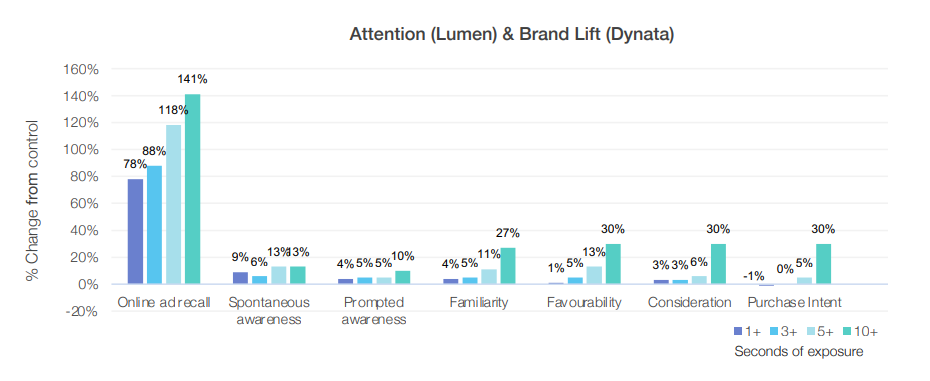‘Clear and direct’ correlation between attention and brand outcomes

There is a “clear and direct” correlation between attention and brand outcomes, especially if viewers engage with ads for longer durations.
That is according to the latest attention study conducted by attention measurement company Lumen Research alongside programmatic digital advertising company Teads and ad effectiveness company Dynata throughout 2022 and 2023.
Brand lift results became more impactful with longer engagement durations, with high attention yielding a consistent improvement across the entire funnel, including mid- and low-funnel metrics with longer dwell times.

The study, titled Unveiling the Connection further found that to generate substantial differences in lower funnel metrics, such as Consideration, it becomes increasingly crucial to prioritise attention.
While a mere 100 milliseconds of attentive exposure can impact ad metrics such as ad recall and brand awareness, achieving significant uplifts in lower funnel metrics requires multiple seconds of engagement.
For example, at least eight “attentive seconds” (i.e., seconds a user pays visual attention to an ad) are required to see significant impact in improving purchase intent. Nine seconds are needing to significantly impact consideration, while three seconds are needed to significantly impact familiarity.
Overall, the positive impact of attention on lower funnel objectives yielded a 30% lift from exposures of 10+ seconds.
“In the initial stages of attention measurement, clients would be wowed by a total amount of attention a campaign had driven with little indication as to what it actually meant,” said Ben Flux, group investment director at Starcom. “A focus on how to tangibly use attention was very much needed. To develop a more strategic approach, understanding the sufficient level of attention needed to drive an outcome is pivotal. This study gives us a much more real use of attention and enables a far more strategic and logical approach to activation.”
Unveiling the Connection is the largest global meta-analysis of combined third-party attention and brand lift metrics yet conducted. It reviewed 16 campaigns involving 14 advertisers across North America, APAC, and EMEA, and encompassed various brands across categories such as global CPG, retail, financial services, travel, charity, fashion, and electronics.
Its release follows a number of other attention measurement studies in recent years, and provides further evidence of the impact of attention on key ad campaign performance indicators.
The findings underscore the role of making a strong first impression with advertising, which can lead to tangible business outcomes if audiences’ attention is captured. They also hint that non-performance metrics are harder to obtain in short attention span environments.
Earlier this summer, Teads announced it was integrating attention metrics into its own programmatic buying platform. It follows a number of other agencies, like Dentsu and Mediahub, that have also integrated attention into their ad offerings, especially in pairing it with carbon reduction practices.
Attention was found to more likely yield statistically significant results for Ad Recall, including familiarity, favourability, consideration, and purchase intent.

It further found that attention is a much stronger predictor than viewability; it was found to be more likely than viewability to yield statistically significant results not just for Ad Recall but also for deeper-funnel measures, such as spontaneous awareness.

“This is a landmark study that can help establish best practices for attention-first advertising, showing why context, creative and time spent with an ad are directly correlated with engagement and conversion.” said Lumen MD Mike Follett. “Whilst this latest report with Teads definitively proves that time viewed is one of the central and most important metrics for attention data when it comes to proving outcomes, we can also clearly see that attention is a complex topic that requires sophisticated modeling and media planning to drive brand growth.”



